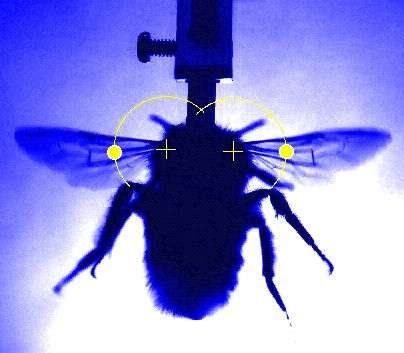(Phys.org) —Two researchers from Japan's Synchrotron Radiation Research Institute have found evidence that bees share a wing muscle contraction mechanism with vertebrates by using X-rays and high speed cameras. In their paper published in the journal Science, Hiroyuki Iwamoto and Naoto Yagi describe how they constructed their observation platform and their interpretation of what they observed.
Scientists have long suspected that muscles used by insects to cause their wings to beat ultra-fast must differ from muscles used by humans and other vertebrates. Research over the years has revealed that muscles in vertebrates are caused to contract by calcium ions being released after signaling from motor nerves. The ions are snared by troponins which exist on another type of protein called actin. This causes filaments on the actin to rotate which in turn leads to exposing the head of yet another protein called myosin—a motor protein. Once binding occurs, the myosin molecule reacts by contracting. While this process works well in vertebrates, it's far too slow and energy consuming to be used by insects—though insect muscles have been found to share the same basic components. Prior research has shown that insect wings can beat so quickly because once they start moving, they oscillate, seemingly spontaneously—how this happens is still a mystery.
To learn more, Iwamoto and Yagi glued a live bumble bee to a metal tube and illuminated it from behind. They also set up an X-ray source to shoot the bee from the side. Next, they set up two cameras, one pointed head-on to the bee, the other set behind a vacuum tube and image intensifier that allowed for capturing data from the side. This arrangement allowed for capturing both internal and external elements of the bee's wing anatomy at 40 frames per beat.
Movie of the wing-beat of a bumblebee, containing a whole wing-beat cycle. The yellow dot indicates the wing position determined by software. Credit: Science/AAAS
In analyzing what they observed, the researchers found that the myosin heads in the muscle rotate when stretched which enables them to bind more strongly. This, they suggest means that the interaction between myosin and actin is a basic property of both muscle oscillation in bees and activation in vertebrates.
This movie explains how the mechanism of stretch activation works in the two antagonistic muscles in the thorax of a flying insect. Credit: Hiroyuki Iwamoto
The team's lab experiments still don't fully explain how it is that bees and other insects are able to cause their wings to oscillate the way they do, but they do shed new light on a mystery that researchers have been trying to solve for several decades.
More information: The Molecular Trigger for High-Speed Wing Beats in a Bee, Science DOI: 10.1126/science.1237266
ABSTRACT
The high-frequency wing beat of higher-order insects is driven by self-sustained oscillations of constantly activated flight muscles. However, it remains unknown whether its underlying mechanism is based on flight muscle–specific features or on preexisting contractile functions. Here, we recorded x-ray diffraction movies, at a rate of 5000 frames per second, simultaneously from the two antagonistic flight muscles of bumblebees during wing beat. Signals that occurred at the right timing for triggering each wing-beat stroke were resolved in both muscles. The signals likely reflect stretch-induced myosin deformation, which would also enhance force in vertebrate muscles. The results suggest that insects use a refined preexisting force-enhancing mechanism for high-frequency wing beat, rather than developing a novel mechanism.
Journal information: Science
© 2013 Phys.org























